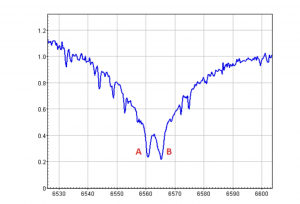“2021年IOAA理论第7题-Menkalinan(五车三)”的版本间的差异
Jingsong Guo(讨论 | 贡献) (创建页面,内容为“==英文题目== ==中文翻译== ==解答==”) |
(→英文题目) |
||
| 第1行: | 第1行: | ||
==英文题目== | ==英文题目== | ||
| + | Almost half of the stars that we see are either binary or multiple star systems. A well-known example of this is Menkalinan (Beta Aurigae), which was initially thought to be a single star, but today recognised as a binary system comprising two stars that we will refer to as Menkalinan A and B. In the following figure, a spectrum of the system (obtained by the observatory of the Universidad de los Andes, in Bogotá) is shown: | ||
| + | [[文件:1005142540.png|居中|缩略图]] | ||
| + | Spectrum of Menkalinan binary system in the region of $$H_{\alpha } $$. Y-axis is for the relative flux, and X-axis measures wavelengths. Menkalinan A is marked as A in the graph, and Menkalinan B is marked as B. | ||
| + | Answer the following questions using the plot and noting that the wavelength of $$H_{\alpha } $$ line in the laboratory frame is $$656.28 𝑛𝑚$$. Assume circular orbits, and assume that the binary system as a whole is at rest with respect to the observer. | ||
| + | |||
| + | 7.1 In the spectrum, we can see the $$H_{\alpha } $$ line for each star in the system. Calculate the line-of-sight velocity of each star (km/s) and determine, at the time of this observation, which of the two stars is moving towards us.(5.0pt) | ||
| + | |||
| + | 7.2 The binary system is located $$81.1$$ light years from Earth and has an orbital period of $$3.96$$ days. The semi-major axis for Menkalinan B (smaller star) was measured to be $$3.35 𝑚𝑖𝑙𝑙𝑖𝑎𝑟𝑐𝑠𝑒𝑐𝑜𝑛𝑑𝑠$$. If the mass ratio of the two components is 1.026, find the total mass of the system (in solar masses).(4.0pt) | ||
| + | |||
| + | 7.3 Calculate the individual masses of Menkalinan $$𝐴$$ and $$𝐵$$ in solar masses.(2.0pt) | ||
| + | |||
| + | 7.4 Since Menkalinan $$𝐴$$ and $$𝐵$$ are main sequence stars, use the relation: | ||
| + | |||
| + | <nowiki>$$\frac{L}{L_{\odot }} =\left ( \frac{M}{M_{\odot }}\right )^{3.5} $$</nowiki> | ||
| + | |||
| + | to estimate the luminosity of each star (in solar luminosity).(2.0pt) | ||
| + | <br /> | ||
==中文翻译== | ==中文翻译== | ||
==解答== | ==解答== | ||
2022年10月5日 (三) 14:30的最新版本
英文题目
Almost half of the stars that we see are either binary or multiple star systems. A well-known example of this is Menkalinan (Beta Aurigae), which was initially thought to be a single star, but today recognised as a binary system comprising two stars that we will refer to as Menkalinan A and B. In the following figure, a spectrum of the system (obtained by the observatory of the Universidad de los Andes, in Bogotá) is shown:
Spectrum of Menkalinan binary system in the region of $$H_{\alpha } $$. Y-axis is for the relative flux, and X-axis measures wavelengths. Menkalinan A is marked as A in the graph, and Menkalinan B is marked as B.
Answer the following questions using the plot and noting that the wavelength of $$H_{\alpha } $$ line in the laboratory frame is $$656.28 𝑛𝑚$$. Assume circular orbits, and assume that the binary system as a whole is at rest with respect to the observer.
7.1 In the spectrum, we can see the $$H_{\alpha } $$ line for each star in the system. Calculate the line-of-sight velocity of each star (km/s) and determine, at the time of this observation, which of the two stars is moving towards us.(5.0pt)
7.2 The binary system is located $$81.1$$ light years from Earth and has an orbital period of $$3.96$$ days. The semi-major axis for Menkalinan B (smaller star) was measured to be $$3.35 𝑚𝑖𝑙𝑙𝑖𝑎𝑟𝑐𝑠𝑒𝑐𝑜𝑛𝑑𝑠$$. If the mass ratio of the two components is 1.026, find the total mass of the system (in solar masses).(4.0pt)
7.3 Calculate the individual masses of Menkalinan $$𝐴$$ and $$𝐵$$ in solar masses.(2.0pt)
7.4 Since Menkalinan $$𝐴$$ and $$𝐵$$ are main sequence stars, use the relation:
$$\frac{L}{L_{\odot }} =\left ( \frac{M}{M_{\odot }}\right )^{3.5} $$
to estimate the luminosity of each star (in solar luminosity).(2.0pt)
